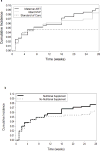Effect of Postnatal HIV Treatment on Clinical Mastitis and Breast Inflammation in HIV-Infected Breast-feeding Women
- PMID: 28205255
- PMCID: PMC6029881
- DOI: 10.1111/ppe.12337
Effect of Postnatal HIV Treatment on Clinical Mastitis and Breast Inflammation in HIV-Infected Breast-feeding Women
Abstract
Background: The relationship between mastitis and antiretroviral therapy among HIV-positive, breast-feeding women is unclear.
Methods: In the Breastfeeding, Antiretrovirals, and Nutrition (BAN) study, conducted in Lilongwe, Malawi, 2369 mother-infant pairs were randomized to a nutritional supplement group and to one of three treatment groups: maternal antiretroviral therapy (ART), infant nevirapine (NVP) or standard of care for 24 weeks of exclusive breast-feeding and 4 weeks of weaning. Among 1472 HIV-infected women who delivered live infants between 2004 and 2007, we estimated cumulative incidence functions and sub-distribution hazard ratios (HR) of mastitis or breast inflammation comparing women in maternal ART (n = 487) or infant nevirapine (n = 492) groups to the standard of care (n = 493). Nutritional supplement groups (743 took, 729 did not) were also compared.
Results: Through 28-weeks post-partum, 102 of 1472 women experienced at least one occurrence of mastitis or breast inflammation. The 28-week risk was higher for maternal ART (risk difference (RD) 4.5, 95% confidence interval (CI) 0.9, 8.1) and infant NVP (RD 3.6, 95% CI 0.3, 6.9) compared to standard of care. The hazard of late-appearing mastitis or breast inflammation (from week 5-28) was also higher for maternal ART (HR 6.7, 95% CI 2.0, 22.6) and infant NVP (HR 5.1, 95% CI 1.5, 17. 5) compared to the standard of care.
Conclusions: Mastitis or breast inflammation while breast-feeding is a possible side effect for women taking prophylactic ART and women whose infants take NVP, warranting additional research in the context of postnatal HIV transmission.
Keywords: Mastitis; breast-feeding; human immunodeficiency virus; infant nevirapine; prophylactic antiretroviral therapy.
© 2017 John Wiley & Sons Ltd.
Figures


References
-
- World Health Organization. Mastitis: Causes and Management. 2000
-
- Foxman B, D’Arcy H, Gillespie B, Bobo JK, Schwartz K. Lactation mastitis: occurrence and medical management among 946 breastfeeding women in the United States. Am J Epidemiol. 2002;155(2):103–114. - PubMed
-
- Marshall BR, Hepper JK, Zirbel CC. Sporadic puerperal mastitis. An infection that need not interrupt lactation. JAMA. 1975;233(13):1377–1379. - PubMed
-
- Kinlay JR, O’Connell DL, Kinlay S. Incidence of mastitis in breastfeeding women during the six months after delivery: a prospective cohort study. Med J Aust. 1998;169(6):310–312. - PubMed
-
- Gomo E, Filteau SM, Tomkins AM, Ndhlovu P, Michaelsen KF, Friis H. Subclinical mastitis among HIV-infected and uninfected Zimbabwean women participating in a multimicronutrient supplementation trial. Trans R Soc Trop Med Hyg. 2003;97(2):212–216. - PubMed
Publication types
MeSH terms
Substances
Grants and funding
LinkOut - more resources
Full Text Sources
Other Literature Sources
Medical
Miscellaneous

